- Home
- Encyclopedia
- Freight, Stage and Mail: The Rawlins-Fort Washa...
Freight, Stage and Mail: The Rawlins-Fort Washakie Road
After the Civil War, gold and then the Union Pacific Railroad began drawing large numbers of Euro-Americans to what soon would become Wyoming Territory. In 1867, prospectors found big nuggets near South Pass; the following year the boom brought 2,000 or more miners to dig in the gulches around South Pass City, Atlantic City and Miner’s Delight.
About the same time, Cheyenne was founded when the tracks first reached it; they were completed across Wyoming by the end of 1868 and the following spring linked up with the Central Pacific in Utah, making the railroad transcontinental. Briefly, South Pass City was larger than all the brand-new railroad towns except Cheyenne, which soon became the territorial capital.
Also at this time, a treaty signed in 1868 between the government and the Eastern Shoshone Tribe vastly reduced that tribe’s holdings and proposed to move its Indian agency—where Eastern Shoshones would receive their treaty-obligated, annual payments of government goods, or annuities—from Fort Bridger up to the warm Wind River Valley, north of South Pass and down at a more livable elevation. Partly to have troops near the new Indian agency, and partly to protect the miners at South Pass from raids by other tribes, in 1869 the Army built Camp Augur on a site that six years later would become Lander, W.T. In 1870, the post was renamed Camp Brown, and in 1871 Camp Brown was moved 16 miles northwest to the current site of Fortt Washakie, on the reservation.
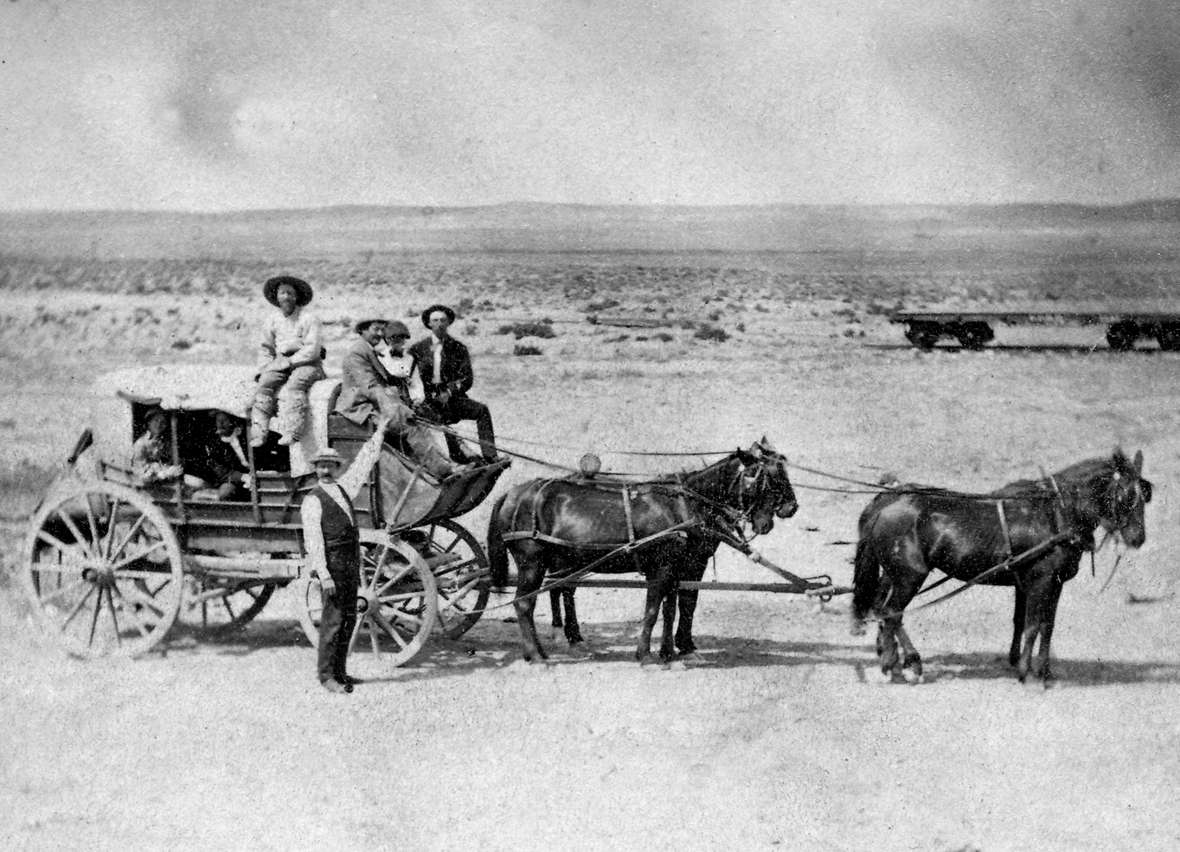
Old trails had to be improved and new roads had to be built in order to supply these new settlements with mail, goods and people. This is the story of the roads that served those places.
The first road used to connect the railroad to these new settlements ran from Bryan, on the railroad, over South Pass, following the old Oregon Trail for much of that distance. Beginning in 1874, the terminal for these new settlements’ mail was switched 12 miles east from Bryan to Green River City. But since the government had constructed a large freight warehouse in Bryan, supplies for both the Army and the Indians, as well as most of the freight for the new settlements continued to be shipped from Bryan until late July of 1879.
The mail would continue to use the South Pass route through 1885. But after 1879, the road from Rawlins, on the railroad 125 miles east of Green River, to the Indian agency at Fort Washakie by way of Lander became by far more important for freight and passengers. It followed an easier grade than the earlier road over South Pass, covered about the same distance from railroad to destination, and kept to lower elevations and thus milder weather.
It didn’t always make for a happy trip, however. On April 6, 1886, for example, the Laramie [Wyoming] Daily Boomerang reported, “N.B. Apple, a well-known commercial traveler from Omaha, came in this morning having just made a trip to Lander, and other points in upper Wyoming. … He took the stage at Rawlins—it was an open vehicle, with a severe storm prevailing part of the time … The accommodations along the route, if they could be called such, were detestable. It was impossible to get anything fit to eat at the stage stations, and the horses fared worse than the men. … The men working at the stations all seemed to be drunk. … ‘I’ve made a good many trips that I thought were tough,’ said Mr. Apple, ‘but this one took the cake.’”
Mail contractors bid low
In October 1873, the Post Office began advertising for bids on new contracts to carry mail from the railroad to interior points in Wyoming. Bids for the route over South Pass to Camp Brown ranged from $16,000 to $3,900. Given that the previous contractor had been paid $9,666 for the route, $3,900 was absurdly low. Nobody could provide satisfactory mail service for this amount of money, but the Post Office awarded the contract to the low bidder, J.W. Ellis. Even after the departure point for the route was changed from Bryan to Green River, in 1878, low bidding would continue.
A new route to Camp Brown
In early 1878, the federal government began exploring better options for hauling freight. On Feb. 2, 1878, the Rawlins-based Carbon County News reported, that the Carbon County commissioners had been asked to locate a road from Rawlins to Camp Brown as soon as possible, to estimate the number of bridges needed and “other work necessary to make a good practicable road.” Among other advantages, a route starting from Rawlins would save the government the cost of hauling freight from the East an additional 123 railroad miles west to Green River.
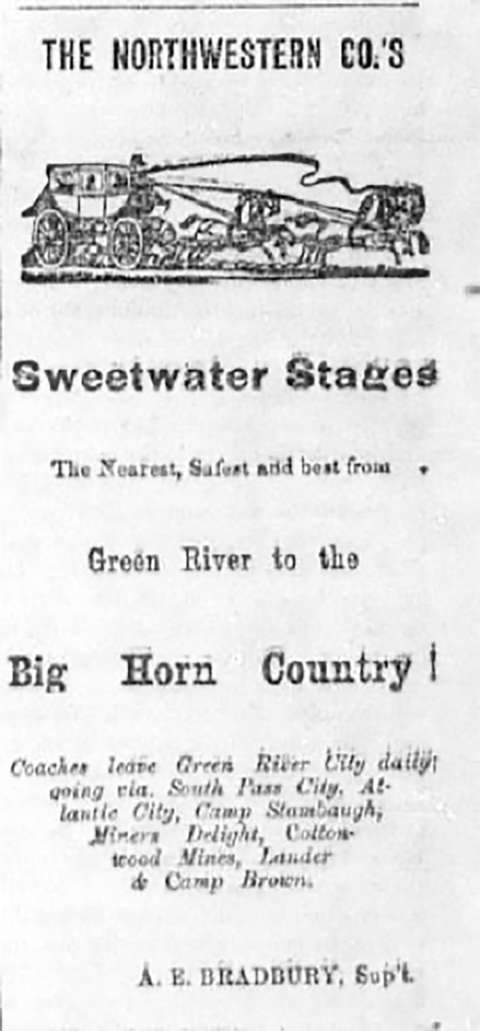
At first, the county commissioners were reluctant to commit any funds to this project. Nevertheless, in March, the U.S. Army Corps of Engineers began surveying the route. The survey party arrived in Rawlins March 9. Second Lt. Foster of the 5th Cavalry reported to the News that the proposed road was 158 miles long, going by way of “’ Muddy Gap,’ and some other cut-offs he mentioned, which we have forgotten.” (In fact, the road ended up going through Crook’s Gap, south of present Jeffrey City.)
In June of that year the Carbon County commissioners realized this route would benefit Rawlins businesses, and solicited bids for the roadwork. August Lankin, the low bidder at $550, got the contract.
On Dec. 30, 1878, meanwhile, Camp Brown was renamed Fort Washakie to honor Chief Washakie of the Eastern Shoshones.
Construction continued through the first part of 1879, with Army troops working on portions of the road while Lankin’s men were also building it. “This road will open Rawlins up to a large country, which has heretofore been cut off for lack of a road,” an unidentified person wrote to the Cheyenne Daily Leader. “[T]here is every reason to expect that all government freight and Indian stores of which there is annually about 3,000,000 pounds of freight to be moved. Beside [sic] the local business to be gained, we can see why the prospects of Rawlins are regarded with such confidence in business circles.”
On July 20, 1879, the Cheyenne Daily Sun reported, “George P. Brown, the contractor for carrying government freight from Rawlins to Fort Washakie and old Camp Brown went north on Wednesday morning to direct the first outfit over the new road. … Freight carried here by the UPRR will now be arriving in Rawlins and forwarded over the new route continually.” The Sun went on, “On Monday last, 40,000 pounds were started over the new Camp Brown (Ft. Washakie) road.”
Shoshone and Arapaho freighters
In 1878, about 900 members of the Northern Arapaho tribe also took up residence on the reservation. In the summer of 1879, to save administrative costs and provide a way for Indians to abandon traditional ways and work for wages, the government began replacing White teamsters with Shoshone and Arapaho drivers. According to local folklore, they had trouble controlling their horses, but apparently newspaper accounts don’t mention this.
“Mr. McCabe from Fort Washakie came in Monday, accompanied by about sixty Shoshone Indians, and thirty freight teams,“ the Rawlins-based Carbon County Journal reported June 25, 1881. “The Indians at the Washakie agency now do their own freighting, using pony teams hitched four to a wagon. They average from eighteen hundred to two thousand pounds of freight on their wagons. … The freight they are now taking out consists of provisions, clothing, hardware and iron. . . . The Arapahoe freight teams are expected to arrive here in about ten days, they having already made one trip this season.”
The contents of their loads varied, as indicated by a report in the June 3, 1883, Cheyenne Daily Leader: “There were forty-five Indian freighters from the Shoshone Agency, under Mr. Charles Yarnell’s instructions passing through Lander today on their way to Rawlins. They are going after the new boiler, engine and other machinery for the new mill out at the agency.”
The Indians were also paid less than White freighters. The Aug. 11, 1884, Carbon County Journal reported, “[T]o Agent Martin’s credit, that seeing the immense discrimination of pay between hauling between Indian and White freighters—the Indians getting but $1.12 ½ per 100 pounds, while the white freighters get more than double that, he wrote to Washington a strong, pointed, and argumentative appeal.”
The Indian freighters often brought along others from the reservation, so that a wagon train might be longer than just the freight wagons. They also hauled goods from the reservation to sell, as the Sept. 20, 1884, Carbon County Journal reported. “About eighty teams with Indian drivers left Fort Washakie last Friday for Rawlins. They will load out with annuity goods. The Arapahoe train of freighters, 51 all told, left Fort Washakie today in charge of Frank Wurtz, as wagonmaster. They take down a large lot of buffalo robes, buck, elk and other skins for the eastern market.”
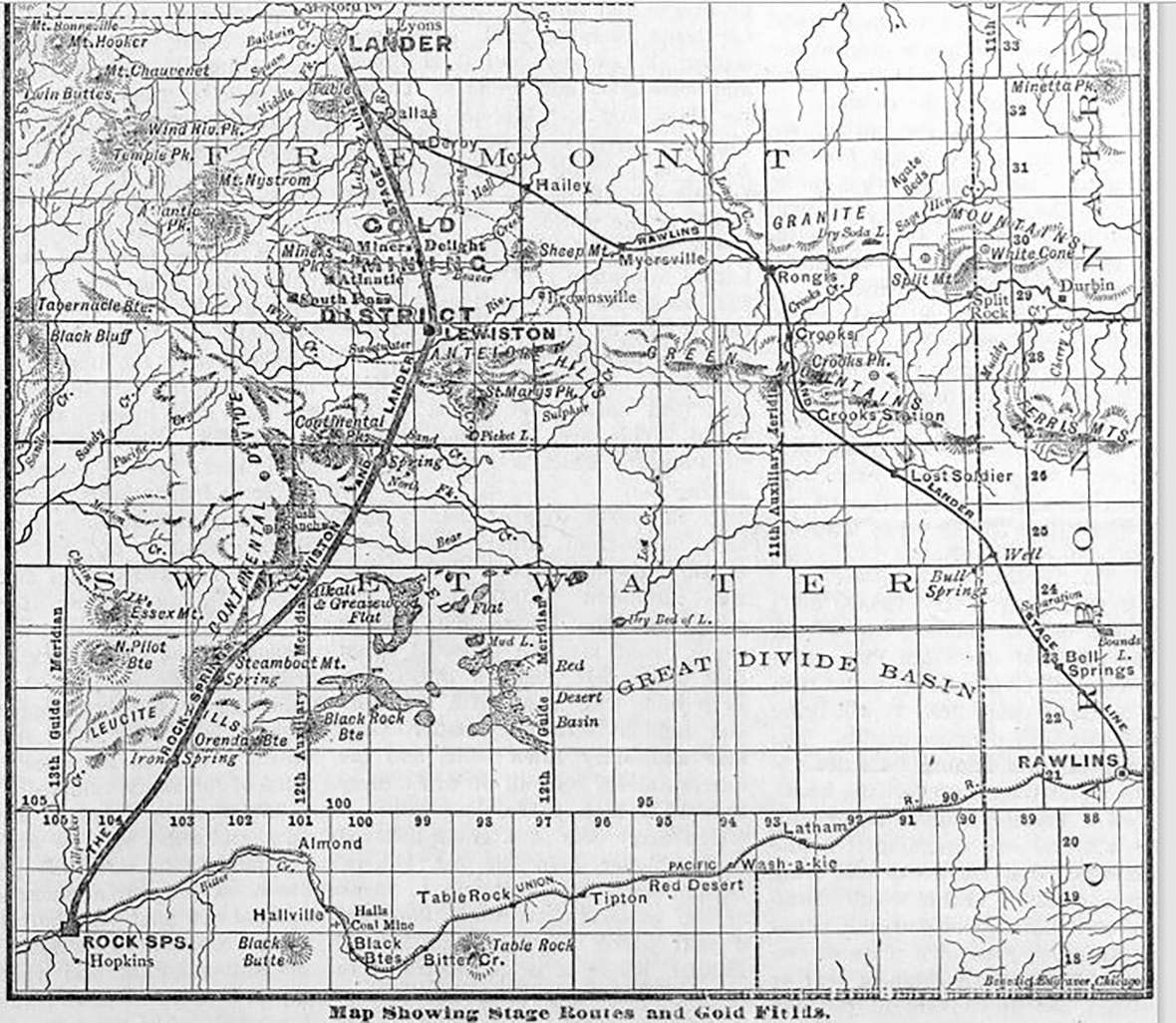
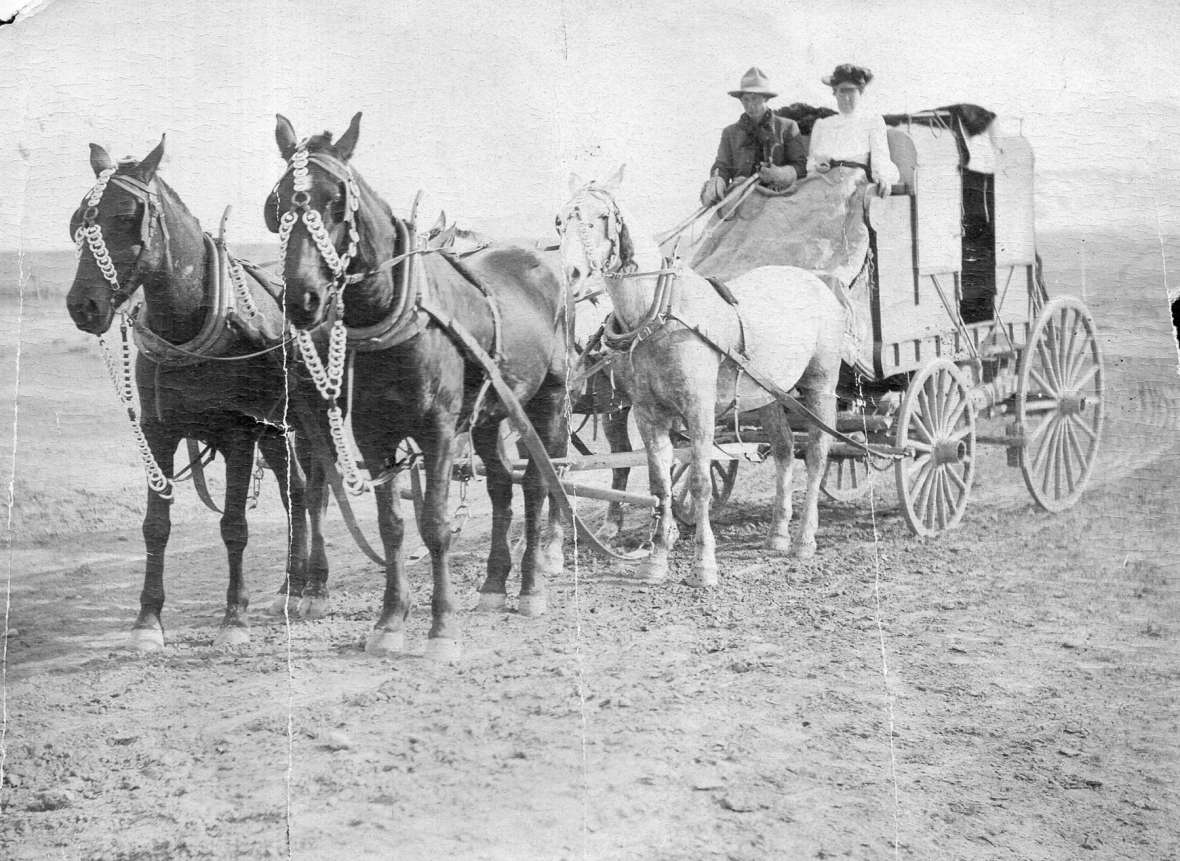
Corruption on the Green River mail route
Although the Rawlins freight road had been established in 1879, contractors continued to deliver mail to South Pass City and Lander from Green River until March 1, 1885. The route was plagued with problems, especially corruption among the contractors. Low bids were part of their practices; sometimes the winning contractor sold his contract to an unsuspecting target and pocketed the difference. Perhaps more frequent were the “dummy” contractors, the lowest few bidders who probably weren’t real people. The swindlers had submitted both the lower and higher bids and, by running the route awarded to the supposed lowest bidder, then declaring the effort a failure after a few months, they forced the postal authorities to accept progressively higher bids.
Crooked contractors also cheated by underfeeding their horses, and by not fulfilling the terms of a contract. For example, the Post Office might order mail service for daily deliveries instead of three times per week, with a corresponding rise in the contractor’s fees. Then the contractor would continue the less frequent service, knowing that no inspector was likely to visit and discover the ruse.
The situation became a scandal. On July 11, 1881, The New York Times described how the swindles worked. The Times also quoted from a letter to the postal department by whistleblower J.W. Wolff: “Some months ago I repeatedly called your attention to abuses on this [Green River to Fort Washakie] route, and showed that the Government was paying for a daily service 150 miles long over a desert for the benefit of less than 500 people. I was met by the excuse that there was no money with which to pay agents to make an examination. … Want of funds seems to be a very lame excuse when the correction of this one fraudulent contract would pay for all the agents needed in that whole region, leaving a large margin of surplus, and enabling the Government to detect and cure many similar frauds.”
The blizzard of 1883
Corruption was not the only problem plaguing the route from Green River to South Pass—at around 7,500 feet in elevation. Disaster struck the stage line with a blizzard that began Jan. 30, 1883. Three men and a young woman froze to death while traveling on stages between South Pass City and Green River City. Two other men, stage driver Al Dougherty, and W. J. Stewart, superintendent of the stage line, managed to survive, though both were crippled. Dougherty, a notorious brawler and blasphemer, continued to drive stages for decades afterward.
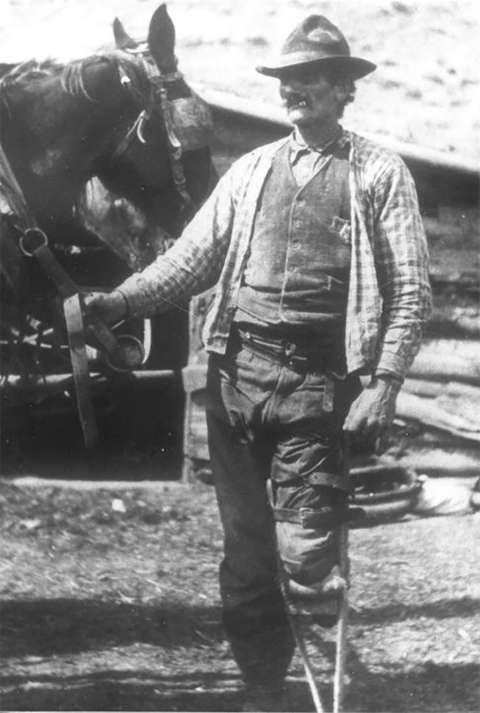
James Sherlock, nephew of Maggie Sherlock, an 18-year-old girl who died in the snowstorm, wrote years later that open sleighs had been substituted for stagecoaches to make travel possible through the snow. “When the sleigh set out from the Dry Sandy station,” he wrote, “the snow was so thick the driver lost his way, returned to the station, and started out again. Again he lost the road and though making little progress, continued for hours. … The snow, which the wind now blew at a terrific rate, had piled into huge drifts, through which the horses drawing the sleigh floundered with great difficulty.”
By now it was night, the temperature was dropping but the snow was thick and wet. “Under these frightful conditions, the team driven by Mr. Ryder became exhausted,” Sherlock wrote, “and when he drove into a depression filled with snow, he was unable to urge the team forward. There the sleigh remained until the storm was over.”
Contractors took such dangerous chances because they faced fines if the mail was late; a large fine could bankrupt an honest contractor. Sure enough, the postal authorities did levy a fine of $267 on two contractors for failure to deliver the mail on time that January.
After that, many people in and around Lander were afraid to ride on the Green River stage—especially if the weather was even slightly inclement. Residents of Fremont County sent many petitions to Washington, D.C. trying to get the mail and stagecoach route changed to the Rawlins-Lander road. These petitions and the sharply declining population in the South Pass mining region were probably the main reasons the Green River route was ended.
Passenger stagecoaches from Rawlins to Lander
On Aug. 4, 1883, about four years after the Rawlins route had been established for freight, the first actual stagecoach ran between Rawlins and Lander. (For a month previous, mail and passengers rode in a lumber wagon.) On Sept. 1, Carbon County Journal editor John Friend published an account of his recent trip:
“Last Wednesday morning we boarded the coach of the Rawlins and Northwestern Stage Line, our destination being one of the most beautifully situated towns in Wyoming. Promptly at nine o’clock the driver Mr. C.W. Slade mounted the box and we bowled away. At Bell Springs the first change of horses was made. This is also an eating station kept by Mrs. Hayes. After partaking of a hearty dinner, we were soon on the way, the writer taking a seat upon the box beside the driver, whom we found to be a very gentlemanly and entertaining sort of person. … Mr. Slade is a first class stage-man, and makes his time with apparently little effort to himself and the stock, holding his ribbons with grace, and applying the silk with an aesthetic ease astonishing to see. … [The road] is smooth and level, with no heavy hills to weary and fag a team. Near Lost Soldier there are several miles of rocky road, round washed boulders as large as a man’s head. A little money expended here to pick the loose ones out of the road would be a great improvement. Still, this road is not rough and rocky like the old stage road is between Cooper Creek and Medicine Bow. At Signor’s we stopped for the night. This is considered the half-way station, and is as far as the coach runs—a spring wagon running from here to Lander. Signor keeps an eating station for the line, and also has a small general store—tobacco and liquors being the principal items stocked.”
The Rongis stage station and bar
The bar at Signor’s, owned by brothers John J. and Eli Signor, in fact had an unsavory reputation. The small settlement there, Rongis, (“Signor” spelled backwards) was located on the Sweetwater River about three miles west of present Jeffrey City. After its first three years in Rongis, in June 1886, the Rongis post office was moved nine miles south to the “Hutchinson Ranch,” located in Crook’s Gap. This explains why many maps drawn in the late 19th and early 20thCenturies show Rongis to be located in Crooks Gap. Over the years, the Rongis post office was moved back and forth between the town of Rongis and a variety of ranches in and around Crook’s Gap.[*]
Reporting on a typical violent episode at the Rongis bar, the Sept. 22, 1888, Carbon County Journal mentioned Charlie Davis, a ranch hand who
“began drinking, and drank freely and became exceedingly noisy, and kept his companions corralled at the bar, forcing them to drink with him. He made the remark to [Eli] Signor during the morning when remonstrated with in regard to his conduct, that he (Signor) better keep quiet, or he would 'get it.' Signor, not desiring any trouble, left the bar and went over to the blacksmith shop to help set a tire, leaving one of his men to take charge of the saloon. … Soon, Davis jumped on the billiard table and scuffed up the cloth, then threw the billiard balls around the room, and also broke some of the chairs and other furniture. The man in charge of the bar finally sent for Signor to come and take over before Davis destroyed everything. In the meantime, Signor had put a pistol in his pocket before he went back in the saloon. As he stepped in the door, Davis met Signor and told him to come and take a drink. Signor refused, telling Davis he didn’t want him breaking up any more furniture and instructing him to behave himself.”
In the ensuing scuffle, Signor shot Davis, apparently in self-defense. The report continued,
“The act was clearly justifiable. Davis had been flourishing his pistol all morning, and kept the crowd in the saloon against their will. Signor made no effort to escape after the shooting. The coroner was sent for and Davis’ body left lying where it fell. A jury was empaneled, and their verdict was ‘justifiable homicide.’ Davis bore a poor reputation, and … [was] considered a bad man. Signor’s reputation as a peaceful, law-abiding citizen has always been first class.”
Owen Wister on the route
Despite Friend’s positive account of his stagecoach ride in 1883, service from Rawlins had apparently deteriorated by 1888, as described by Owen Wister, author of The Virginian, in a diary entry from July 22 when he was on his way to Fort Washakie to pick up a guide and go hunting in the Wind River Mountains:
“The stage company may not make any living for itself, but it assuredly swallows the livings of other people. There were three of us, and we had 400 pounds of extra baggage. For the journey of 150 miles we paid $86.20. Moreover, you have four horses and a wide Concord stage no longer. Two horses, and a narrow stage, and half our baggage left behind to follow us the next day. The express boxes from Chicago [Wister traveled west on the train] had now caught us up … and here we left them behind again, along with all our blankets and all our ammunition …”
“Altogether, the time between our rising and our departure was a black period. We left Rawlins five in number. The balance [of the party] stayed with our baggage to come when it could. … About six [o’clock] we stopped nowhere in particular with a hot axle. … So we grew more and more behind time, and the next driver, who came on about nine or so, when all warmth had gone and the moon shone cold and brittle, was a crank who lost half an hour for each one he drove. My turn on the box outside came about twelve-thirty or later, and that stage was bitter. The driver said he was numb under his coats, and I had no coat. I do remember that the world looked very beautiful in the moonshine, all lines being soft and uncertain and the sagebrush very silver-like—but it was too damned cold for romance and nature. The look of my own shadow sticking out of the shapeless black cast by the stage seemed to lower the temperature.”
Mail from Rawlins
Though the Rawlins-Fort Washakie freight route was established in 1879, mail was still carried from Green River to Lander until March 1885, even though the population of the South Pass area mining district was declining. For some time Post Office officials experienced political pressure to continue carrying mail to South Pass directly from Green River, but finally saw no point in keeping South Pass on the main route. In addition, Carbon County commissioners were more willing to spend money on a road than were Sweetwater County commissioners.
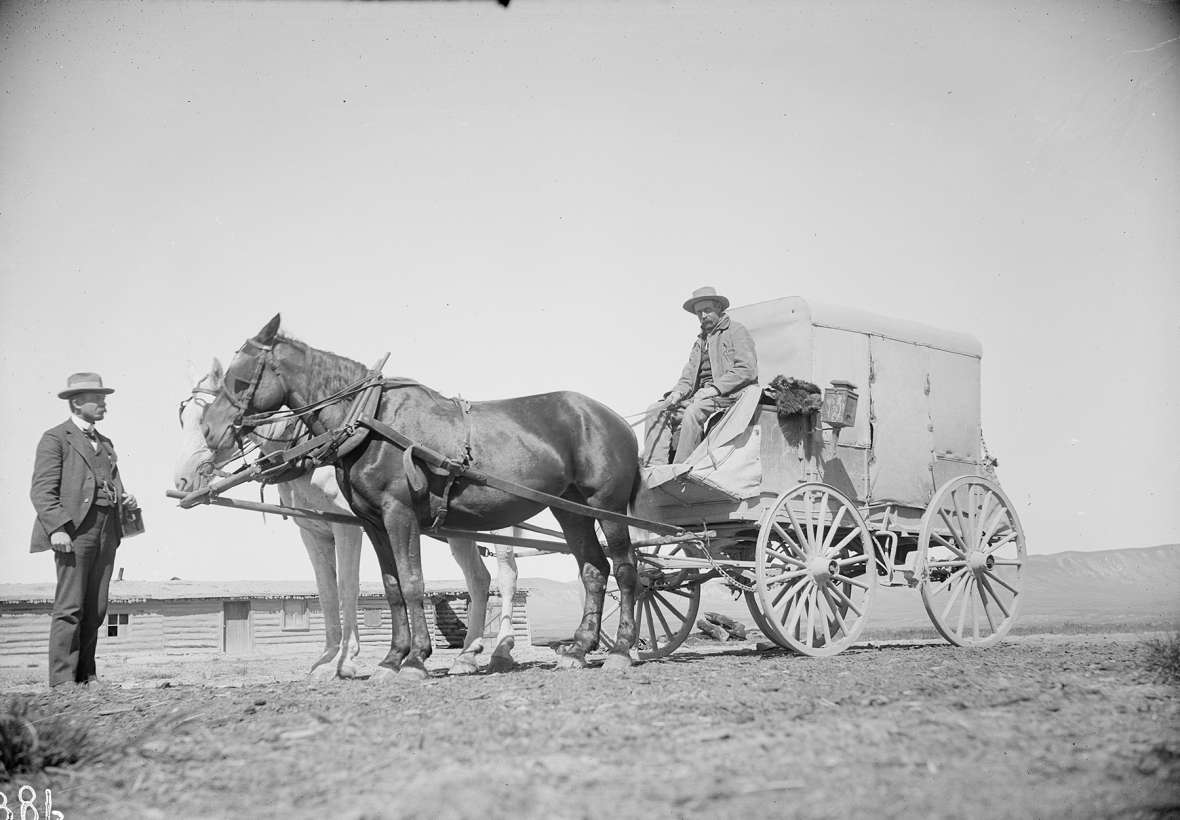
The hazards of Beaver Hill
Beaver Hill, now known as Beaver Rim, is about 33 miles southeast of Lander, where the road climbs steeply from the Wind River Basin up to the plateau along the Sweetwater River. It was a dangerous spot on the route. Unless a coach was lightly loaded, passengers had to walk both up and down the steepest stretches. Before starting down the hill, drivers rough-locked the rear wheels to keep them from turning, which slowed the coach, but the descent was still hazardous.
On July 7, 1888, the Carbon County Journal wrote, “The Lander Mountaineer reports: ‘Beaver Hill on the Rawlins-Fort Washakie stage road is so steep that horses going down the steep declivity, unless they are attached to wagons, fall over on their necks. Thursday, as Major Baldwin’s outfit was going down the steepest part of the hill, an animal following behind fell and broke its neck. It was one of the Major’s mules, and a good one. The roads need attention from the county all the way from Beaver Hill to Lander.’”
Stagecoach and mail service between Rawlins and Lander ends
Mail and passenger service continued from Rawlins to Lander and Fort Washakie for 23 years until June 30, 1906. On July 11, 1906, the Rawlins Republican published a letter from the Rawlins Postmaster, written to be sent out on the last coach to make the journey.
To Postmaster Brown,
Lander Wyoming:“Goodbye; this office has handled your mail for nearly 20 years. [sic] I am glad you are soon to have a railroad. It will be an agreeable change for you. … God bless the old stage line; she is doomed, but it beat walking.”
“With the best wished for you all, goodbye.”
Perry L. Smith P.M.
In 1906, the Chicago and North Western Railroad completed a new line from Casper through Shoshoni to Lander. Vastly reducing the use of the stagecoach, this and other railroad spurs facilitated mail, passenger and freight service to the area served via the Rawlins-Fort Washakie route for almost a quarter century. All along, government funds had fueled the development of Wyoming thanks to the need to supply military posts and the reservation—and to keep the mail running more or less on time.
Resources
Primary Sources
- Powell, William Henry. Powell’s Records of Living Officers of the United States Army, 107, accessed June 5, 2021 at https://www.ebooksread.com/authors-eng/william-h-william-henry-powell/powells-records-of-living-officers-of-the-united-states-army-hci/page-107-powells-records-of-living-officers-of-the-united-states-army-hci.shtml.
- United States Congress, House of Representatives. Executive Documents of the House of Representatives for the Third Session of the Forty-Fifth Congress, 1878-79, Vol. 17. Wyoming Territory, Offers for Carrying the Mails, 420, accessed June 5, 2021 at https://books.google.com/books?id=dJoFAAAAQAAJ&pg=PA420&dq=offers+and+contracts+route+37109+green+river+city+camp+brown&hl=en&newbks=1&newbks_redir=0&sa=X&ved=2ahUKEwjV_dGFjuzsAhWRtZ4KHY1zCbEQ6AEwAXoECAcQAg#v=onepage&q=offers%20and%20contracts%20route%2037109%20green%20river%20city%20camp%20brown&f=false.
- United States Congressional Serial Set, Vol. 1693. Allowances Made to Contractors, 1310, accessed June 4, 2021 at https://books.google.com/books?id=XlNHAQAAIAAJ&pg=PA1310&lpg=PA1310&dq=1875+allowances+to+contractors&source=bl&ots=HgjSuBy-yR&sig=ACfU3U1ep4nfmYm3y_YgrbMWqj2Rr_EyYA&hl=en&sa=X&ved=2ahUKEwiVt63Mg-zsAhXkLX0KHeBxCVgQ6AEwDHoECAkQAg#v=onepage&q=37105&f=false.
- United States Military Academy-Association of Graduates of the United States Military Academy-Class of 1877. Fred Waldron Foster, 47, accessed June 4, 2021 at https://books.google.com/books?id=ZUzpYpePl6AC&pg=RA1-PA46&lpg=RA1-PA46&dq=lieutenant+fred+waldron+foster&source=bl&ots=qYndRVUO9G&sig=ACfU3U085hgDAgiOdTh25p41OTAzOL7rEA&hl=en&sa=X&ved=2ahUKEwjg6JDw9-vsAhVYJzQIHWypBacQ6AEwDHoECAsQAg#v=onepage&q=lieutenant%20fred%20waldron%20foster&f=false.
- United States Post-Office Department. Official Register of the United States 1876. Post Offices in Wisconsin and Wyoming Territory, 1206, accessed June 5, 2021 at https://babel.hathitrust.org/cgi/pt?id=loc.ark:/13960/t9b57br0r&view=1up&seq=1228&q1=Lander.
- United States Surgeon-General’s Office, Circular No. 8. A Report on the Hygiene of the United States Army: With Descriptions of Military Posts. Washington, D.C.: Government Printing Office, 1875, accessed May 10, 2021 at https://books.google.com/books?id=gaVd2s1AnZwC&printsec=frontcover#v=onepage&q=Maghee&f=false.
- “Useless Postal Routes.” The New York Times, July 11, 1881. Newspapers.com. Database available to patrons at the Natrona County Public Library, Casper, Wyo.
- Wister, Fanny Kemble, ed. Owen Wister Out West: His Journals and Letters. Chicago: University of Chicago Press, 1958, 64-67, 90-91, 172-175.
- Wyoming Newspapers, accessed June 4, 2021, June 5, 2021 at https://wyomingnewspapers.org:
- The [Laramie] Daily Boomerang, April 6, 1886
- Carbon County Journal, Sept. 1, 1883, Aug. 11, 1884, Sept. 20, 1884, Sept. 22, 1888
- Carbon County News, Feb. 2, 1878, March 16, 1878
- The Cheyenne Daily Leader, March 25, 1879, June 3, 1883
- The Cheyenne Daily Sun, July 20, 1879
- The South Pass News, Oct. 27, 1869
- Wind River Mountaineer, July 6, 1906
Secondary Sources
- Garrett, T.S. “Some Recollections of An Old Freighter.” Annals of Wyoming 3, no. 1 (July 1925): 86-93.
- Guenther, Todd. “The Burnt Ranch Saga: A History of the Last Crossing of the Sweetwater.” Overland Journal 5, no. 4 (Winter 1999-2000): 2-32.
- Jost, Loren. “Fremont County, Wyoming.” WyoHistory.org, accessed June 14, 2021 at /encyclopedia/fremont-county-wyoming.
- Sherlock, James D. South Pass and Its Tales. Basin, Wyo.: James D. Sherlock, 1978, 131-144.
Illustrations
- The 1872 photo of John Silvis presenting the Bryan Stage is from the Sweetwater County Historical Museum in Green River. Used with permission and thanks.
- The 1878 newspaper ad and the map of stage routes are from the author’s collections. Used with permission and thanks. The newspaper ad was collected from Wyoming Newspapers and the map from Joe Ellis, superintendent at the South Pass City State Historic Site.
- The photos of Al “Peggy” Dougherty and the four-horse mud wagon are from the Fremont County Pioneer Museum in Lander. Used with permission and thanks.
- The photo of the two-horse mud wagon at Bull Springs is from the American Heritage Center. Used with permission and thanks.
To further complicate matters, when the Niobrara Stage and Transportation Co. was awarded the mail contact on July 1, 1890, they decided they didn’t want one of their stage stations in the rough and rowdy town of Rongis, so they built a new stage station 2 miles up the river from Rongis. Although the stage company called this place “Home Station,” many residents called the stop “New Rongis.”
